Related Research Articles
Slovak is a West Slavic language of the Czech–Slovak group, written in Latin script. It is part of the Indo-European language family, and is one of the Slavic languages, which are part of the larger Balto-Slavic branch. Spoken by approximately 5 million people as a native language, primarily ethnic Slovaks, it serves as the official language of Slovakia and one of the 24 official languages of the European Union.
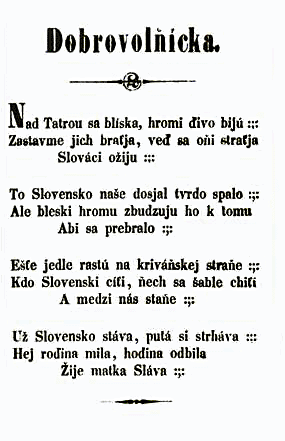
"Nad Tatrou sa blýska" is the national anthem of Slovakia. The origins of it are in the Central European activism of the 19th century. Its main themes are a storm over the Tatra mountains that symbolized danger to the Slovaks, and a desire for a resolution of the threat. It used to be particularly popular during the 1848–1849 insurgencies.

Ludevít Štúr, also known as Ľudovít Velislav Štúr, was a Slovak revolutionary, politician, and writer. As a leader of the Slovak national revival in the 19th century, and the author of the Slovak language standard, he is lauded as one of the most important figures in Slovak history.
The Slovak language is a West Slavic language. Historically, it forms a dialect continuum with Czech. The written standard is based on the work of Ľudovít Štúr, published in the 1840s and codified in July 1843 in Hlboké.

Pavel Jozef Šafárik was an ethnic Slovak philologist, poet, literary historian, historian and ethnographer in the Kingdom of Hungary. He was one of the first scientific Slavists.
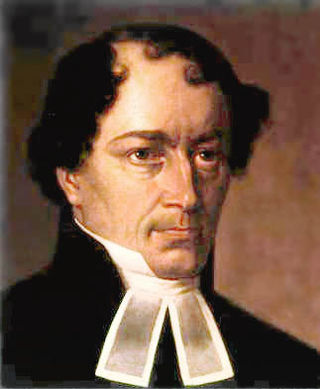
Ján Kollár was a Slovak writer, archaeologist, scientist, Lutheran pastor, politician, and main ideologist of Pan-Slavism.
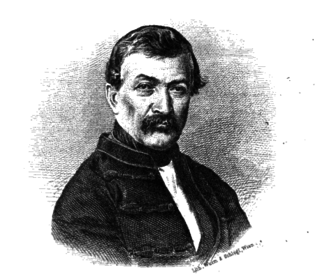
Samo Chalupka was a Slovak Lutheran priest and romantic poet.
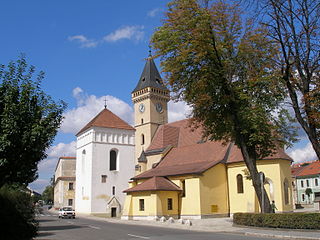
Sabinov is a small town located in the Prešov Region, approximately 20 km from Prešov and 55 km from Košice. The population of Sabinov is 12,700.

Matica Slovenská is the oldest Slovak national, cultural and scientific organization. The headquarters of Slovak Matica is the town of Martin, Slovakia as the center of the national culture of Slovaks, where it was founded in 1863 and revived in 1919. Slovak Matica is a public institution that operates as a national scientific and cultural centre. It has facilities both in the Slovak Republic and abroad. Slovak Matica works to develop and protect the national rights, identity, and development of Slovak culture and the Slovak nation. Slovak Matica is a legal entity. It establishes its organizational units on the territory of the Slovak Republic as well as abroad. The position and activity of Slovak Matica is regulated by Act no. 68/1997 Coll. on the Slovak Matica as amended and the Statutes of Slovak Matica.

Anton Dif Bernolák; Hungarian: Bernolák Antal; 3 October 1762 – 15 January 1813) was a Slovak linguist and Catholic priest, and the author of the first Slovak language standard.

Jiří Třanovský, was a Lutheran priest and hymnwriter from the Cieszyn Silesia. Sometimes called the father of Slovak hymnody and the "Luther of the Slavs," Třanovský's name is sometimes anglicized to George Tranoscius. Both the Evangelical Lutheran Church in America and the Evangelical Lutheran Church in Canada remember his life and work annually, on the anniversary of his death.
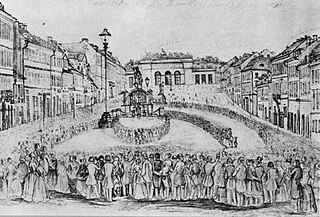
The Prague Slavic Congress of 1848 took place in Prague between 2 June and 12 June 1848. It was the first occasion on which voices from nearly all Slav populations of Europe were heard in one place.
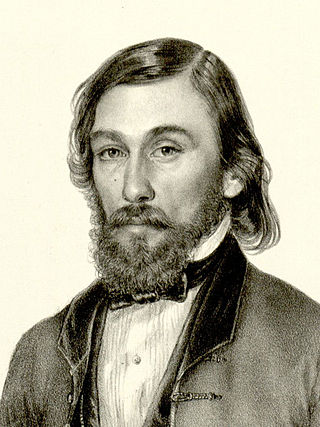
Jozef Miloslav Hurban was a leader of the Slovak National Council and the Slovak Uprising in 1848–1849. He was a writer, journalist, politician, organizer of Slovak cultural life, and a Lutheran pastor. He was a supporter of Ján Kollár, and later of Ľudovít Štúr. His son, Svetozár Hurban-Vajanský, followed in his footsteps both as a writer and nationalist.

The culture of Slovakia is influenced by its Catholic culture, its various folk traditions, and its location in Central Europe. Slovakian culture shares certain similarities with the cultural traditions of its neighbouring countries: Poland, Ukraine, Hungary, Austria and Czech Republic.
Nationality words link to articles with information on the nation's poetry or literature.
Croatian literature refers to literary works attributed to the medieval and modern culture of the Croats, Croatia, and Croatian. Besides the modern language whose shape and orthography was standardized in the late 19th century, it also covers the oldest works produced within the modern borders of Croatia, written in Church Slavonic and Medieval Latin, as well as vernacular works written in Čakavian and Kajkavian dialects.
Juraj Košút was a Hungarian nobleman, a lawyer and a supporter of the Slovak national movement.
Eastern Slovak dialects are dialects of the Slovak language spoken natively in the historical regions of Spiš, Šariš, Zemplín and Abov, in the east of Slovakia. In contrast to other dialects of Slovak, Eastern dialects are less intelligible with Czech and more with Polish and Rusyn.
References
- 1 2 Petro, Peter (1995). A History of Slovak Literature. Liverpool: Liverpool University Press. ISBN 0853238901.
- ↑ Murray, Christopher John. Encyclopedia of the romantic era, 1760–1850, Volume 1. 2004, p.244
- ↑ Seton-Watson, RW (1965). A History of the Czechs and Slovaks. Hamden: Archon.
- ↑ Petro, Peter. A History of Slovak Literature. 1995, p.59
- ↑ Petro, Peter. A History of Slovak Literature. 1995, p.131
- ↑ Petro, Peter.A History of Slovak Literature. 1995, p.134
